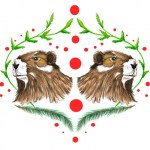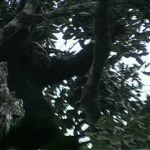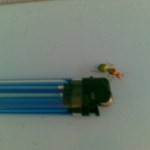I find the music in this video to be completely appropriate.
Below the fold is a description the nice communications lady at the CA Academy sent me...interesting stuff. By the way, if you haven't been to the California Academy of Sciences you are missing out on one of the most state of the art museums in the world.
"At feeding time in the California Academy of Sciences' vine snake exhibit, one blink and you might miss the action. These pencil-thin snakes hunt fish swimming in the water below, striking with lightning speed. We recently captured a feeding on film (http://www.youtube.com/…

New research is ROCKING the notoriously arrogant carnivorous plant scientific community: It appears that the largest carnivorous plant, the giant pitcher plant of Borneo (or the Nepenthes rajah for those in the know), has not evolved into its immense size in order to capture and eat small rodents, but to be a large toilet for furry tree shrews to deposit their nutrient rich feces in.
Don't nobody go in there for thirty-five...forty-five minutes!
Since their discovery in the early Eighteen...ahem...hmmm...(sorry, we're animal guys), the giant pitcher plants have been rumored to ingest not…
It turns out I have more in common with my favorite animal than I thought. NOTE: Usually I find an article and then regurgitate it into the cheeping mouths of our readers in my own words. In this case, I kind of like how the article was written in the first place, so I'm just going to link to it..
Great pic.
Thanks to NVDH for uncovering this one.
P.S. Isn't it hilarious when you go to make a tag called "alcohol" for a piece on the blog, but that tag has already been created? Clearly we've covered this topic before.
Kunekune pigs are being trained by the US Navy to hunt out and disarm undersea anti-ship mines. Or that might be dolphins. The documentation is unclear.
Zooillogix ran across some groundbreaking research being done on tapeworms. The linked abstract below takes you into the life of a tapeworm with extraordinary first hand detail. Enjoy.
I rate this PG-13
Truly, a remarkable piece of science. Only the best for Zooillogix readers.
Have you ever said to yourself, "Self, have you ever said to your self, 'What are African wild animals up to right now?'"
Now you can satisfy your self's overly demanding curiosity with National Geographic's WildCam. Don't worry, unlike most streaming webcam feeds, this is one you won't have to delete from your browser's history. The WildCam program is designed to inspire more talk about conservation by plopping viewers down right in the middle of the wild. Like, the real wild. Like, the no-messin-around-or-animals-gone-eat-you-up wild.
In an age where people are inundated with edited sound…
I'm back. After a two month hiatus from posting due to the grand opening of Bullitt, my second bar in San Francisco, I have finally adjusted my schedule to accommodate posting, and I'm pumped.
First on my list: I have been looking for years for the best endangered species group to put my support behind. I think I've found it, WildAid. Do you know about them? If you live in Asia, then you have. If you live in the states, then maybe not. WildAid is, in my mind, the most badass endangered species preservation group in the world today. Started by wildlife investigators who were fed up with…
Big news! Andrew and I have a new favorite institute! I've always said that Andrew has the same hair as a Cacajao calvus! I may give the Institute a small grant to study this bizarre similarity.
So you know how there aren't as many members of some species as there once was, and in fact some species that used to exist no longer exist? Well, some folks still haven't gotten the message.
In an attempt to bring more recognition (and funding) to the conservation cause, some mighty fine Zartists are collaborating on the Endangered Species Print Project. The project houses artwork that depicts endangered animals, but the print-run of each species' piece is limited to the number of individuals thought to still exist. For instance, a Zooillogix favorite: The Vancouver Island Marmot.
...…
Atlantis. The Loch Ness monster. The National Aquarium. What do these things have in common? They were only fabled to exist, until now! I know what you're thinking, "I've been to the National Aquarium in Baltimore... and I love tater tots and also was once attracted to a cousin." Well, you'd be dead-wrong about the aquarium thing! How is that? Well that's because I'm not talking about the National Aquarium in Baltimore, but the actual 'National Aquarium ' which is in DC. DUH!
And who do we have to thank for proof of existence of this fabled institution? None other than Linda Lombardi of…
There's a really good point that has been brought up many times about scientists. We suck at sharing our results with the public. Or sometimes we share, but in a way that very few people (scientists included) could understand. One of the problems may be a lack of emphasis on the big "So what?" People are much more interested if they understand the relevance of the findings to normal life. I find it helps to relate the concepts to more familiar things in my life.
For example, fish researchers from the University of New South Wales recently published a paper on the effects of small…
If you go through our archives, you won't find too many posts that rise above toilet humor or self-depreciation (I mean, why would you want to?), but I present the exception below. It's a long one, however it's incredibly interesting. I'm sure you'll feel smarter when you're done. And don't worry, we'll be back to posting about Benny's bat obsession or Andrew's batboy resemblance soon.
So we can look back on 2009 and know we didn't waste ALL of your time:
(c) NDR Naturfilm
Well, almost. Here's some info from the Wildlife Conservation Society's press release:
"With the assistance of the Wildlife Conservation Society's Cameroon Program, a film crew from the Hamburg-based NDR Naturfilm managed to video the elusive Cross River gorilla earlier this year in a stand of montane trees after weeks of effort in the Kagwene Gorilla Sanctuary. The protected area was created in 2008, with the guidance of WCS, specifically to protect the world's rarest great ape.
"These gorillas are extremely wary of humans and are very difficult to photograph or film,"…
A research team led by Julian Finn of the Museum of Victoria in Melbourne has discovered octopuses using coconut shells as portable protection. Not only do they hide under single halves but will actually pull two halves together and hide inside, like some sort of Super Mario baddie. The video is remarkable.
Using tools means octopuses now join an elite club of wise animals including chimps, dolphins, and Tim Allen.
Thanks to Salem for sending this along.
Research on the subject suggests that somewhere, somehow our squirmy reaction to incest can be expressed genetically. Because of natural selection and all that blah blah, it's thought that there exists a biomechanism that triggers incest avoidance in humans. Well, it looks like some very bold scientists have found a solid starting point for furthur research: lemur hoo-ha's.
Christine Drea, Marylene Boulet, and Marie Charpentier from Duke University carefully obtained genital gland secretions from 17 sexually mature female ring-tailed lemurs.
Side note: most species of lemurs live in…
An Indonesian Zooillogix reader, Harianto Talim, grossly overestimated our entomological abilities and asked us to help him identify an Indonesian ant that he has never seen before. In this blurry series of photos, you can see that the ant is bright orange and green and may or may not smoke cigarettes. It should be noted however that when confronted about the lighter in the ant's pocket by its mother, the queen, the ant claimed it just carries the lighter around to light other ants' cigarettes to look cool.
So nerdy readers, time to prove your mettle by identifying this random blurry ant!…






